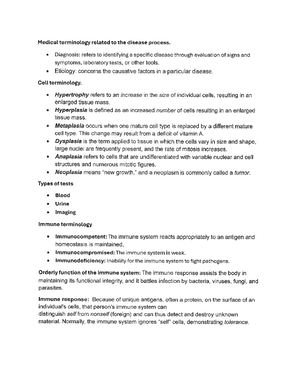- Information
- AI Chat
Was this document helpful?
Antibiotics - Part I Pearls
Course: Pharmacology (NSG 124)
875 Documents
Students shared 875 documents in this course
University: Herzing University
Was this document helpful?

Antibiotics – Part I Pearls
Principles of Antimicrobial Therapy
Antimicrobial drugs are selectively toxic – they disrupt bacterial cells without hurting host cells
oThey do this because bacterial cells have specific differences from mammalian cells
Antimicrobial drugs target these differences
Drugs can be classified by range of organisms they attack
oLehne – Table 83.1, p 1016
oNarrow-spectrum – targets specific organisms
Always preferred when the organism in known
oBroad-spectrum – targets many organisms
Used initially (empirically) when we do not know the organism
Must test for organism before administering these drugs
Must switch to narrow-spectrum when cultures resulted (may take a few days)
Not doing this leads to antibiotic resistance and superinfections
oAntibiotics create imbalance by disrupting normal flora
Drugs can also be classified by how they attack organisms
oLehne – Table 83.2, p 1016
oSeven classification groups – most common are:
Inhibition of cell wall synthesis or destruction of cell wall
Penicillins, cephalosporins, vancomycin, etc.
Interference with protein synthesis
Tetracyclines, macrolides, aminoglycosides, etc.
Bactericidal vs bacteriostatic
oBactericidal drugs kill bacteria
oBacteriostatic drugs slow bacterial growth – do not kill
Antibiotic stewardship
oIn most cases, antibiotics should not be used prophylactically
Much public education still needs to be done on this
oOrganism should be identified, and one antibiotic should be used when indicated
oEducate patients on importance of taking antibiotics for entire duration of prescription
oMonitor and educate patients on adverse effects and when to alert provider
oWhen administering IV antibiotics – never mix or run at the same time
Mixing can cause precipitate (use different tubing as well)
If reaction, difficult to tell which drug caused the reaction when run at the same
time
Penicillins
Beta-lactams (have a beta-lactam ring)
MOA: bactericidal – weaken cell wall, allowing water to fill cell and rupture
More effective against gram-positive bacteria
oGram-positive cells – 2 layers of cell wall
oGram-negative cells – 3 layers of cell wall
Not effective against bacteria that secrete beta-lactamase
oEnzyme that destroys beta-lactam ring
Generally classified on range of organisms they attack
oNarrow, broad, and extended spectrum












